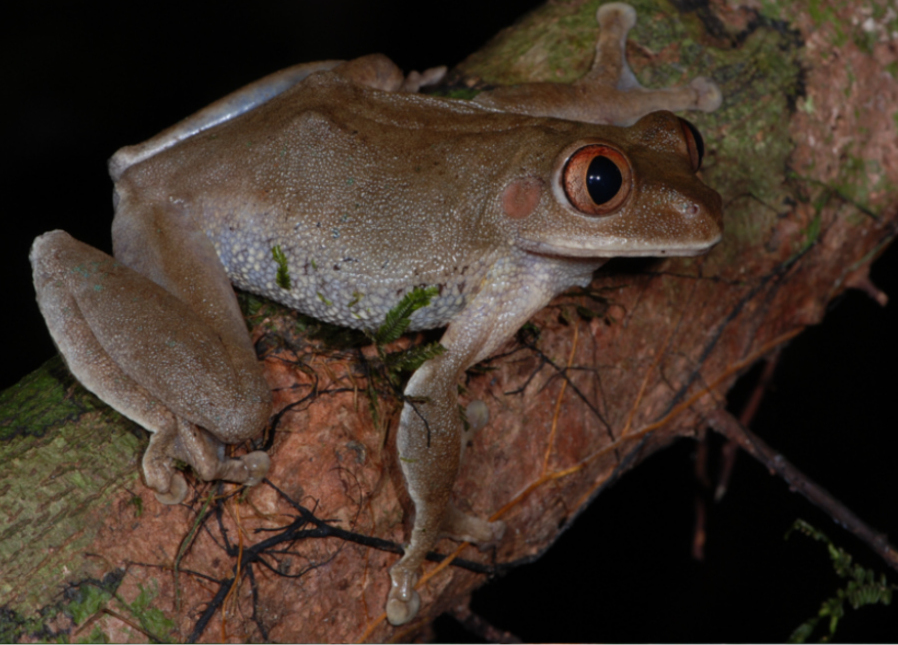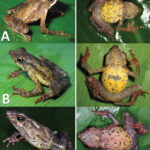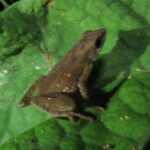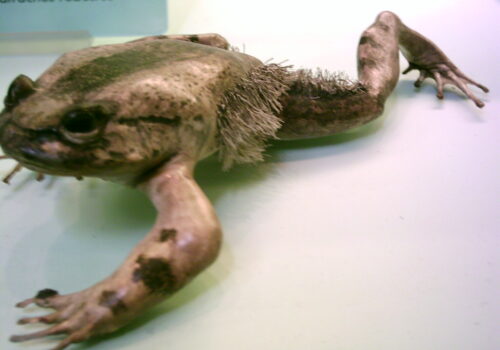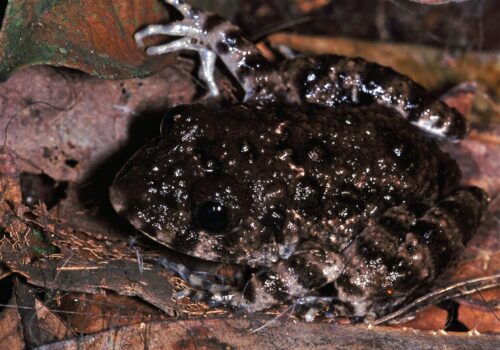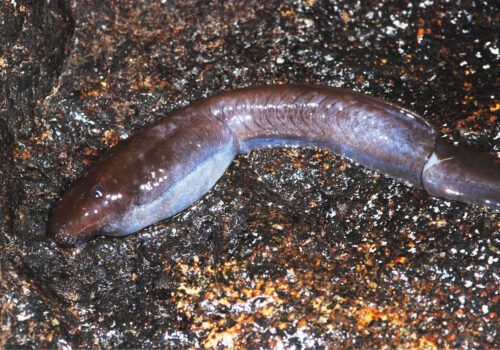- Discovering Leptopelis macrotis: The Enigmatic Big-Eyed Forest Tree Frog
- Taxonomy and Classification
- Natural Habitat: A Dweller of the Rainforest Canopies
- Physical Characteristics: The Windows to its Survival
- Behavior and Life Cycle: Masters of the Nocturnal Domain
- Ecological Role: A Vital Link in Rainforest Health
- Threats and Conservation Status
- Cultural and Scientific Significance
- Conclusion: Protecting the Big-Eyed Wonders
Discovering Leptopelis macrotis: The Enigmatic Big-Eyed Forest Tree Frog#
Hidden amidst the lush green foliage of Africa’s dense rainforests lives a creature whose large, hypnotic eyes have charmed naturalists for generations. Leptopelis macrotis, commonly known as the Big-Eyed Tree Frog or Large-Eyed Forest Tree Frog, is a remarkable yet understated amphibian species. With its intriguing appearance and secretive behaviors, it continues to amaze researchers and wildlife enthusiasts alike, offering us valuable insights into the hidden workings of rainforest ecosystems.
Known scientifically as Leptopelis macrotis, this captivating amphibian is a member of the family Arthroleptidae—a diverse family of frogs found predominantly across sub-Saharan Africa. Despite its quiet reputation, this species plays a critical role within its rainforest habitat. It functions not only as a predator and prey within its environment but also as an indicator species whose presence or absence reflects the health of its delicate habitat.
So, let us journey together into the verdant heart of West Africa, into the secretive lives filled with intriguing adaptations, behaviors, and imminent conservation challenges facing this fascinating frog species.
Taxonomy and Classification#
The Big-Eyed Tree Frog, scientifically recognized as Leptopelis macrotis, belongs to the class Amphibia and order Anura—the order encompassing all frogs and toads. Within the order Anura, it is classified under the Arthroleptidae family, renowned for an impressive diversity of frogs adapted to various specialized habitats across sub-Saharan Africa.
The genus Leptopelis, to which our subject belongs, includes over 50 species distributed widely across central, eastern, and especially western Africa. The distinguishing traits within this genus often include arboreal (tree-dwelling) lifestyles, large expressive eyes, and unique vocalizations that deeply resonate throughout moist forests each mating season.
Closely related species include Leptopelis vermiculatus and Leptopelis calcaratus, yet Leptopelis macrotis remains distinct thanks to its peculiar physical characteristics and behavioral adaptations, solidifying its place within a wonderfully diverse family tree.
Natural Habitat: A Dweller of the Rainforest Canopies#
The natural realm of Leptopelis macrotis extends primarily across the verdant, humid rainforests and seasonal forests of West and Central Africa. Its home range includes countries such as Sierra Leone, Ivory Coast, Ghana, Nigeria, Cameroon, and Equatorial Guinea, among others.
An Arboreal Lifestyle#
Preferring subtropical or tropical moist lowland forests, this amphibian is largely arboreal, spending most of its life within the protective embrace of vegetation. Equipped with specialized toe pads adapted for efficient climbing, this frog is surprisingly agile, maneuvering expertly among canopy and treetop branches, leaves, and vines. The dense foliage of primary and secondary rainforest habitats offers the perfect combination of shelter from predators and ample resources.
The Perfect Microhabitat#
These frogs exhibit a particular fondness for areas near freshwater bodies—stealthily inhabiting shrubs near streams, pools, or marshes essential for breeding and tadpole development. The humid and temperate microenvironment provides ideal conditions for their delicate skin, allowing gaseous exchange and hydration vital for survival.
The complex structure of their forest habitat allows these amphibians to exploit vertical niches where predators are more easily avoided, competition minimized, and prey abundant, marking the frog not just as a mere inhabitant, but as an integrated part of rainforest biodiversity dynamics.
Physical Characteristics: The Windows to its Survival#
The Big-Eyed Tree Frog derives its common name from its most immediate and striking feature: its extraordinarily large and expressive eyes. These oversized eyes, beautifully colored with strikingly golden-brown irises, are one of its primary adaptations—optimized for nocturnal hunting and navigation in a twilight world ruled by shadows.
Coloration and Size#
Adult frogs typically measure between 40-65 mm from snout to vent, displaying sexual dimorphism with females usually slightly larger than males. Their smooth skin ranges from vibrant shades of green and yellow to earthy browns, often interspersed with subtle darker patterns, perfectly mimicking the play of light and shadow on forest leaves.
Adaptations for Survival#
These frogs possess specialized adhesive toe pads, enabling them to climb vertical surfaces and smoothly traverse slippery leaves. This adaptation serves dual purposes—escaping predators quickly and ambushing prey with lightning-speed precision. Their cryptic coloration further enhances their camouflage, blending seamlessly into foliage and dramatically reducing predation risk.
Equipped with oversized eyes sensitive to even faintest light, the frog can detect the faintest movement in the nighttime canopy. Their acute vision allows accurate leaps and captures, granting unparalleled predatory efficiency.
Behavior and Life Cycle: Masters of the Nocturnal Domain#
Primarily nocturnal, the Large-Eyed Tree Frog spends daylight hours safely hidden away under leaf litter, in foliage clusters, or well-camouflaged against tree trunks. At dusk, it awakens to conduct its nightly rituals of hunting, mating, and territorial calling.
Mating Calls and Courtship Rituals#
Males emit melodious calls that characterize rainforest nights, resonating between dense vegetation and amplifying through moisture-rich air to attract receptive females. Calls, often described as a series of melodic clicks and whistles, not only serve to attract mates but also establish territorial presence.
Upon successfully attracting a partner, courtship occurs close to water bodies where the females deposit egg clusters securely attached beneath leaves overhanging streams or rainfall-created puddles. This method cleverly increases survival odds, as hatchlings drop directly into water upon emergence, avoiding terrestrial threats during vulnerable larval stages.
From Tadpole to Froglet#
Tadpoles are entirely aquatic, feeding primarily on algae, microorganisms, and organic debris. Over weeks, morphological transformation takes place—limbs develop, tails slowly absorb, and lungs mature. Newly metamorphosed froglets instinctively climb vegetation, starting their lives high above terrestrial threats and predators.
Ecological Role: A Vital Link in Rainforest Health#
Leptopelis macrotis, like many amphibians, serves as both predator and prey within its ecosystem, maintaining crucial balance and biodiversity. Their diet primarily consists of insects and other arthropods—mosquitoes, moths, beetles, ants, and spiders—helping control insect populations naturally, thus contributing significantly to ecosystem stability.
Simultaneously, they provide important prey resource for bird, reptile, or mammalian predators, thus supporting biodiversity along rainforest trophic levels. As amphibians, they also fulfill valuable roles as indicator species, signaling environmental conditions through sensitive responses to ecological change.
Threats and Conservation Status#
Currently, the International Union for Conservation of Nature (IUCN) lists Leptopelis macrotis as Least Concern. However, pressures from ongoing habitat destruction driven by logging, agriculture expansion, and human settlement appear increasingly threatening. Climate change and pollution further compound these issues, altering water availability and negatively affecting tadpole development.
Conservation Efforts and Future Outlook#
Despite conservation challenges, increased awareness and education programs strive toward improved forest protections, sustainable land-use practices, and habitat preservation policies critical for this frog’s continued survival. Protecting rainforest habitats benefits numerous other wildlife species, emphasizing broad ecological and economic value.
Cultural and Scientific Significance#
Though often overlooked culturally compared to more iconic wildlife, amphibian species like Leptopelis macrotis symbolize biological richness and serve scientific communities crucially. Studies focused on amphibian populations offer vital insights into ecological health, biodiversity dynamics, and biological responses to climate change.
The unique biology and physiology found within Leptopelis macrotis continue inspiring research into habitat conservation, evolutionary adaptation, and ecological resilience. In vivid detail, they alias the interconnectedness and fragility of natural habitats everywhere.
Conclusion: Protecting the Big-Eyed Wonders#
Every creature plays an indispensable role in its environment, from towering elephants to tiny amphibians hidden within the treetops. The enchanting yet humble Leptopelis macrotis provides a vivid illustration of that delicate interconnectedness.
Ensuring the protection of this charming frog and its rainforest habitat relies on continued research, community involvement, heightened conservation efforts, and a genuine appreciation among us all for the quiet wonders of nature. By learning, understanding, and advocating for the protection of species like Leptopelis macrotis, we protect Earth’s biodiversity for generations yet to come.








